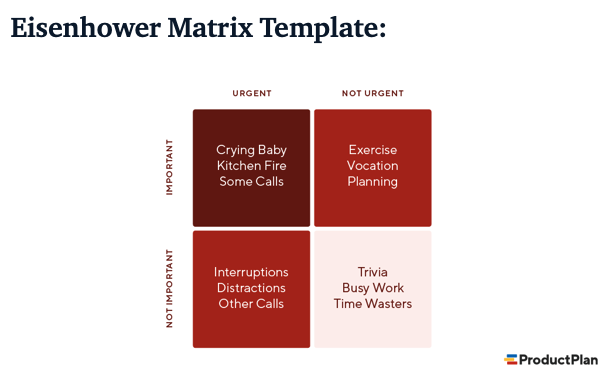Product management is a challenging discipline that requires efficient decision-making and prioritization skills. With numerous tasks and responsibilities demanding attention, it can be overwhelming to determine which tasks should be prioritized and which ones can be postponed. In such scenarios, the Eisenhower Priority Matrix, also known as the Urgent-Important Matrix, comes to the rescue. Developed by former US President Dwight D. Eisenhower, this matrix provides a valuable framework for organizing tasks and making effective decisions. In this blog post, we will explore the benefits of using the Eisenhower Priority Matrix in product management and discuss potential challenges to be considered.

Benefits of the Eisenhower Priority Matrix in Product Management:
- Clear Prioritization: The Eisenhower Priority Matrix classifies tasks into four quadrants: Important and Urgent, Important but Not Urgent, Urgent but Not Important, and Not Urgent or Important. This classification allows product managers to identify and focus on tasks that truly matter. By differentiating between urgency and importance, it becomes easier to allocate time and resources efficiently.
- Improved Time Management: The matrix enables product managers to allocate time more effectively. By focusing on important tasks before they become urgent, they can prevent unnecessary crises and ensure smoother project execution. It helps in eliminating the procrastination trap, allowing teams to stay ahead of deadlines and deliver high-quality products.
- Enhanced Decision-making: The Eisenhower Priority Matrix helps in making informed decisions by providing a structured approach to evaluating tasks. It prompts product managers to consider the long-term impact of tasks and prioritize those that align with strategic goals and objectives. This methodology reduces decision fatigue and ensures that efforts are directed towards tasks that bring the most value to the product and the organization.
- Increased Productivity and Focus: By utilizing the Eisenhower Priority Matrix, product managers can increase their productivity by focusing on important tasks and minimizing distractions. By consciously allocating time for strategic planning and product improvements, they can create a positive impact on the overall product roadmap. This approach allows for better resource allocation and boosts the team’s productivity and morale.
Potential Challenges:
- Subjectivity in Task Classification: Determining the importance and urgency of tasks can sometimes be subjective, as individuals may have different perspectives and priorities. It is crucial to establish clear criteria for task evaluation to ensure consistency and avoid misunderstandings.
- Adaptability to Dynamic Environments: The Eisenhower Priority Matrix assumes a relatively stable and predictable environment. However, in the fast-paced world of product management, priorities can change rapidly. Product managers need to be flexible and adjust their task classifications accordingly to accommodate shifting demands and unexpected events.
- Overemphasis on Urgency: While the matrix helps identify urgent tasks, it is important to remember that not all urgent tasks are necessarily important. Overprioritizing urgent but low-impact tasks can lead to a neglect of strategic initiatives. It is crucial to strike a balance between addressing immediate needs and investing time in long-term goals. This is what is known as the “urgency trap”.
- Implementation Challenges: Introducing the Eisenhower Priority Matrix into an organization may require training and change management efforts. Some team members may initially struggle to adapt to the new framework, and it might take time for them to fully embrace its benefits. Proper education and communication are essential to ensure a smooth transition and maximize the matrix’s effectiveness.
The 4th challenge is critical to understand. The process requires adoption across your organization to be fully effective. Also, you can play around with the axis titles as well. If urgent and important aren’t aligned to the business needs, you can use the “level of effort” and “business value” as substitutes.
The Eisenhower Priority Matrix is a powerful tool that can significantly enhance product management efficiency. By enabling clear prioritization, improving time management, enhancing decision-making, and boosting productivity, this framework equips product managers with a structured approach to handle their responsibilities effectively. However, it is important to acknowledge the potential challenges associated with its implementation, such as subjectivity in task classification and adaptability to dynamic environments. By understanding these challenges and addressing them proactively, product managers can leverage the Eisenhower Priority Matrix to its full potential and achieve better outcomes for their products and organizations.





